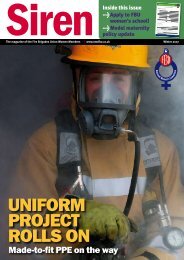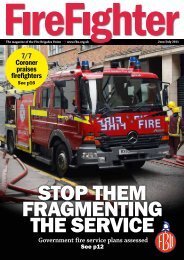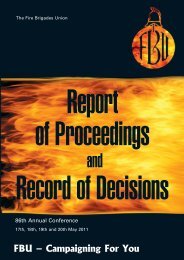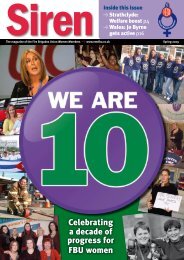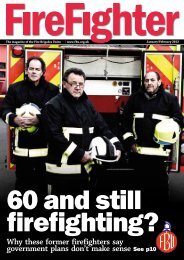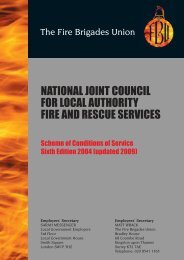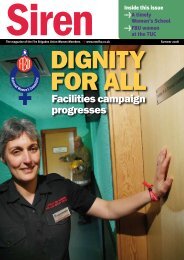Report - Fire Brigades Union
Report - Fire Brigades Union
Report - Fire Brigades Union
Create successful ePaper yourself
Turn your PDF publications into a flip-book with our unique Google optimized e-Paper software.
SECTION B — FIRE AND RESCUE SERVICE POLICY<br />
<strong>Fire</strong>link/FiReControl<br />
76) The original timetable to complete FiReControl by<br />
December 2007 was tied to the completion of <strong>Fire</strong>link, the<br />
new digital radio system, which had a delayed completion<br />
date of December 2007. <strong>Fire</strong>link is providing the vast<br />
majority of the benefits claimed for RCCs and is very<br />
technically challenging in its own right.<br />
77) While we know <strong>Fire</strong>link radio technology can work for<br />
brigade level controls there has to be a question mark over<br />
its capacity to work across several fire services regionwide.<br />
There are already genuine question marks about the<br />
capacity of Airwave, which is now a private monopoly<br />
supplier to the emergency services, given the increasing<br />
burdens being placed on it.<br />
78) Delays to <strong>Fire</strong>link do have a knock-on effect on<br />
FiReControl. Some of these were set out in a national<br />
project manager’s update, <strong>Fire</strong>link Strategic Snapshot –<br />
December 2007. This acknowledged that a number of fire<br />
services did not update their existing controls – known as<br />
legacy systems – because the new RCCs were meant to<br />
be in place by the end of 2007.<br />
79) Delays to both the <strong>Fire</strong>link and FiReControl projects meant<br />
“interim solutions” had to be put in place to cope with the<br />
late-running of both projects. Additional work had to be<br />
carried out for what was described as the “longer<br />
extended interim solution”.<br />
80) Problems identified in the <strong>Fire</strong>link Phase A operational<br />
rollout included: Fit out of eight pilot vehicles in each FRS:<br />
“temporarily stalled in the first tranche of regions due to<br />
delays by Airwave in providing test scripts.” Issues with<br />
training “eg lack of training equipment.”<br />
81) Problems were identified in the Phase B launch date<br />
(the fit out of the main vehicle fleets). This was<br />
“progressively delayed as a result of… over ambitious<br />
forecasting and inadequate groundwork by Airwave…<br />
delays in submission of test scripts for Phase A<br />
acceptance work… knock-on effects of the (preceding)<br />
police resilience programme.”<br />
82) These issues meant “Airwave roll out forecasts have been<br />
drifting increasingly out of synchronisation with events on<br />
the ground since the late summer”. The result was a<br />
“realism adjustment” – a euphemism for a further delay.<br />
<strong>Fire</strong>link project managers reported they had been able “to<br />
persuade Airwave fully to reflect the reality of where we<br />
are and their track record to date by adding a significant<br />
amount of contingency to their forecasting.”<br />
83) This strategic snapshot is also revealing in a number of<br />
other points. Concerns about the fitting of aerials to<br />
officers’ cars threw up other concerns about “the evolving<br />
FiReControl concept of operations appears now to be<br />
shifting beyond the current <strong>Fire</strong>link scope of supply based<br />
on a wider interpretation of the term ‘resilience’. Separate<br />
work is therefore now in hand… to clarify the FiReControl<br />
concept of operations…”<br />
84) The concept of operations would play a major role in<br />
setting out the technical specifications for the contract<br />
agreed with EADS. That it was still evolving at this stage –<br />
there was still no fixed concept of operations – would<br />
make it much more difficult to establish the technical<br />
solution.<br />
85) The same report includes part of a letter from Richard<br />
How, the senior civil servant heading up the FiReControl<br />
project on a day to day basis. This letter, to the <strong>Fire</strong>link<br />
team, reveals there were already concerns about delays for<br />
FiReControl arising a matter of months after EADS secured<br />
the contract.<br />
86) It revealed that Mr How had written to the <strong>Fire</strong>link team at<br />
the end of August 2007 about “concerns that the release<br />
dates for a number of products – in particular Convergence<br />
and Data Schema – from EADS were later than planned.”<br />
Mr How told the <strong>Fire</strong>link team, operating from within the<br />
same department and upon which FiReControl depended,<br />
that EADS provided some information but that it would “be<br />
counter-productive” to share that with them at that time.<br />
87) By November Mr How could still not share the information.<br />
He could say that “Since then we have been working<br />
closely with EADS to develop a comprehensive set of<br />
robust plans in which we all have confidence… However,<br />
EADS is not as far advanced as they and we hoped they<br />
would be… this lack of information is preventing the FRS<br />
from developing their detailed activity and resources<br />
plans… the failure to deliver to date is inevitably creating<br />
concerns about the capability to deliver as they have<br />
contracted… the delay in providing information is<br />
compressing the time available that that (sic) the FRSs<br />
have to complete their activities…”<br />
88) It would be unfair to Airwave and EADS not to point out<br />
that these documents only set out the views of CLG<br />
project managers. These comments may be unfair to one<br />
or both contractors, may not fully set out the full picture or<br />
be self-serving in other ways.<br />
89) What is clear is the department was not ensuring the<br />
proper flow of full information between the key personnel<br />
and the key contractors working on two closely related<br />
projects. If anything, the department was a barrier to the<br />
flow of critical information between and within both<br />
projects.<br />
Overview – getting it wrong from the start<br />
90) The project is defined to operate under the Prince 2 project<br />
management process. Like all project management<br />
processes these define tasks, timelines, costs,<br />
checkpoints/gateways, actions, personnel, risks and should<br />
include for contingencies. The documented hierarchy<br />
published in the Business Cases (Part 1 and Part 2)<br />
provides for the accountability.<br />
91) The published delays do not account for the difference in<br />
time from the original proposal and the current end date.<br />
There must therefore have been significant delays during<br />
FBU Annual <strong>Report</strong> 2011 69





